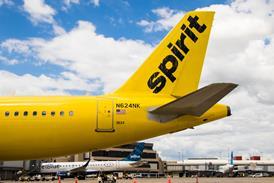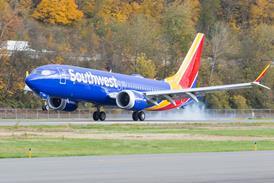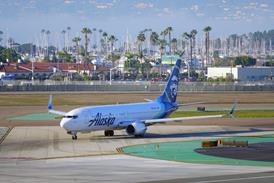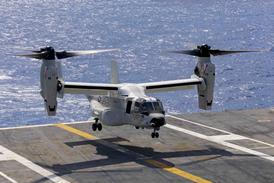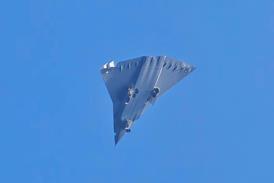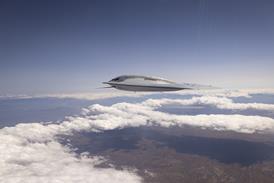Two high-profile fatal accidents in late December created the impression that airline safety began a downward trend in 2024. But although global airline safety performance did see more fatal accidents and fatalities than during any year since 2018, the difference was in fact not statistically dramatic once compared with the annual average of the past 10 years.
The number of airline fatal accidents and fatalities worldwide in 2024 were 16 and 333, using our reporting categories, marking increases from six and 115 the previous year (see graph, below). However, this statistical comparison is misleading because 2023 was the safest 12 months in the history of the global commercial air transport industry.
| World airline fatal accidents and fatalities, 2015-2024* | ||||||||||
| 2015 | 2016 | 2017 | 2018 | 2019 | 2020 | 2021 | 2022 | 2023 | 2024 | |
| Fatal accidents | 9 | 13 | 12 | 14 | 22 | 12 | 15 | 12 | 6 | 16 |
| Fatalities | 176 | 306 | 56 | 543 | 297 | 332 | 134 | 229 | 115 | 333 |
| Source: FlightGlobal *Including fatal events known to be caused by deliberate action | ||||||||||
The major losses recorded as last year drew to a close included the crash of an Azerbaijan Airlines Embraer 190 on 25 December. Some 38 people were killed when the aircraft crashed while its crew attempted a diversion to Aktau, Kazakhstan from its original intended destination: Grozny in Russia.
Post-impact images showing shrapnel damage to its tail section and control surfaces prompted suspicion that it had been engaged and damaged by a Russian surface-to-air missile.
On 29 December, the year’s deadliest accident resulted in 179 passengers and crew being killed when a Jeju Air Boeing 737-800 collided with obstacles in the runway overrun area after touching down with its landing gear retracted at Muan airport in South Korea.
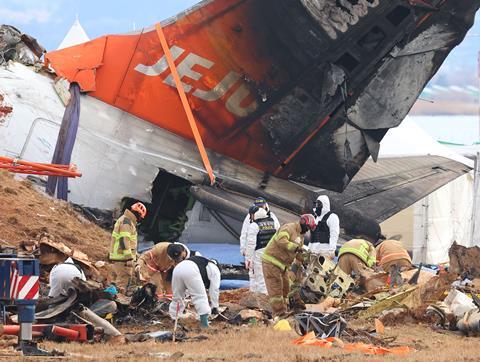
“The tragic loss of two jet airliners in the closing days of the year, resulting in the death of 217 passengers and crew, underlines the potentially catastrophic nature of the industry,” says Paul Hayes, director of air safety and insurance at Cirium. “These two losses changed 2024 from being a ‘good’ year into the worst for loss of life since 2018. However, this does not mean that air travel has somehow suddenly become less safe.
“There are, fortunately, very few fatal airline accidents these days and, as we saw in 2024, one event with a high loss of life can make all the difference to the headline numbers and, indeed, to the headlines,” Hayes notes.
Compared against recent years, 2024 was unusual in one respect: several scheduled passenger jet operations feature in the fatal accident category (see accident listings download at foot of article). Frequently there have been none, with losses usually confined to turboprops, or to non-passenger operations.
Other incidents involving passenger jet aircraft last year included a Singapore Airlines 777-300ER (one passenger died as a result of in-flight turbulence during a 21 May service from London Heathrow), and a Swiss Airbus A220-300 (a cabin crew steward died after a smoke and fumes event in the aircraft).
EMERGENCY DIVERSION
The Swiss A220 event – which happened in the cruise during a Bucharest to Zurich service on 23 December, prompting an emergency diversion to Graz and evacuation via slides – appears unique for several reasons. There has not yet been publication of an autopsy report following the death in hospital of the cabin crew member, but initial examination showed that he had suffered brain damage. All five crew members received medical care following the incident, including one who was airlifted to hospital.
Swiss says one of the aircraft’s Pratt & Whitney PW1500G engines failed – it has not elaborated, beyond saying that the failure had not happened before and that there is not a critical safety issue. Unverified early reports suggest that the powerplant may have seized owing to oil loss.
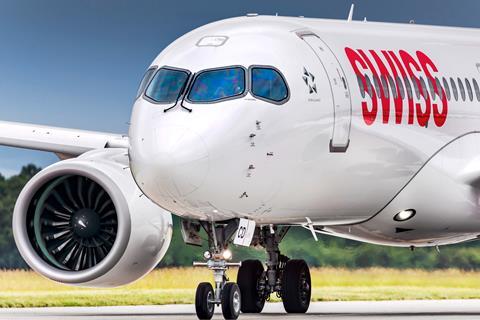
An event on 9 August that caused particularly high casualties involved a Brazilian domestic flight by a Voepass ATR 72-500. The aircraft was flying from Cascavel to Sao Paulo, had been airborne for about 1h 20min and was cruising at 17,000ft: a level right in the middle of an altitude band for which a significant weather warning was active, alerting the crew to the presence of severe icing conditions.
Turboprop aircraft are more vulnerable to icing conditions than jets because their engines cannot produce as much hot bleed air and electric power for airframe anti-icing purposes. Three ATR-family aircraft have been lost to icing over the years, starting with an American Eagle ATR 72 in Indiana in 1994.
Although the Voepass crew were clearly aware of the presence of icing, and frequently operated the available de-icing systems, their actions and verbal exchanges as captured on data recorders suggest that they did not appreciate the degree of risk they faced, and they made no effort to escape the icing conditions by changing their height or routing.
Just after they began their descent toward Sao Paulo the aircraft stalled and entered a spin from which it did not recover. All 62 people on board died.
In addition to its actual losses, the airline industry needs to remind itself constantly of how close it regularly comes to disaster.
Two serious mishaps in early January 2024 fell into this category only because they were handled with great skill by their crews. If the pilots’ actions had not succeeded, the fatalities total for last year could have increased by a further 556.
An inquiry into the first of those events – a Japan Airlines (JAL) A350 landing collision at Tokyo Haneda airport on 2 January 2024 – is still ongoing. The Japanese Transportation Safety Board (JTSB) had hoped to report on it within a year, but is still struggling to pin down all factors that have a bearing on why such a collision could have happened, despite measures designed to make it impossible.
What did occur was a classic runway incursion event of the worst kind. A Japan Coast Guard De Havilland Canada Dash 8, taxiing out urgently in darkness to carry out an emergency relief flight, lined up on the active runway without air traffic control (ATC) clearance.
The JAL A350 was on short final approach to land, but its pilots could not see the lights of the small aircraft among the high intensity runway approach and threshold lights. ATC had cleared the Dash 8 to taxi only as far as the holding point for runway 34R, but the stop-bar lights at that position were out of action for maintenance: this had been made public via NOTAMs.
Another factor being examined by the JTSB is that Haneda has a runway conflict alert system that was activated by this incursion, but controllers said that it generates nuisance warnings so often that they usually ignored it in favour of visual confirmation. However, this collision – which killed all but one of the Dash 8’s six crew members – took place at night.
Details still emerging from the JTSB inquiry about the successful evacuation of all 367 passengers and 12 crew from the A350 make crystal clear what a well-executed exercise it was. Fire was taking hold at many points around the widebody-twin when it finally slid to a halt, so many of the electronic systems had been damaged in the collision that the pilots had no intercom communication with the cabin crew, and the starboard engine refused to shut down.
The captain and co-pilot left the flightdeck and spoke with the cabin crew to order the evacuation. Because of the visible presence of fire outside, only the front left and front right doors, plus the aft-most door on the left side, were used to evacuate those on board. The majority left via the front two doors, with only about 20-30 exiting via the rear-left door.
Despite gathering smoke, the captain checked the entire length of the cabin to ensure that no-one remained on board before escaping via the rear-left door. Reports confirm that no-one attempted to carry passenger baggage with them.
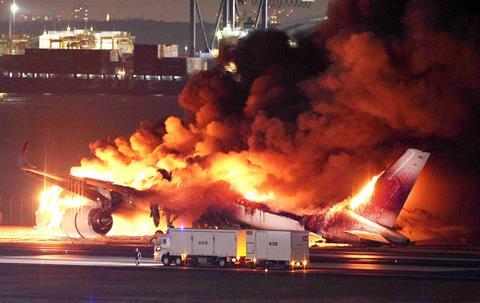
The other near-catastrophe – on 5 January 2024 – involved the sudden decompression of an Alaska Airlines 737 Max 9 when one of its mid-fuselage emergency exit door-plugs blew out at 16,000ft in the climb. This was subsequently attributed to a mistake by Boeing mechanics who had incorrectly carried out a post-maintenance re-fit of the unit during final assembly.
Their lapse was not picked up by supervisors, adding to existing evidence that Boeing had still failed to regain control of its quality assurance and safety culture. It was this loss of safety discipline that was blamed for two fatal 737 Max accidents, in 2018 and 2019.
When the door-plug blew out during the flight, the crew immediately carried out the emergency depressurisation drill and returned to their point of departure: Portland International airport. Fortunately, nobody among the 171 passengers and six crew were killed.
EGYPTIAN ALLEGATIONS
Also of note last year, an accident report into an Egyptair A320 crash in May 2016 was finally released by the Egyptian authorities. They claim the loss of control that caused the aircraft (SU-GCC) to plunge into the Mediterranean Sea was started by explosive material that was ignited in or near the forward galley, just aft of the cockpit. This, says the report, started a fire while the aircraft was in the cruise at 37,000ft over the eastern Mediterranean.
The report, however, contains a rebuttal from France’s BEA accident investigation agency – an official observer at the inquiry – which states that there is no evidence of explosive chemicals. Instead, the BEA believes that the fire started in or near the co-pilot’s oxygen mask regulator: the cockpit voice recorder includes the sound of oxygen being emitted from it.
Fire, when it took hold, caused damage to flightdeck computers and cables, soon rendering the aircraft uncontrollable. It crashed close to the Egyptian coast, killing all 66 people on board.
“Physical evidence is incompatible with the scenario of an explosion that damaged the [aircraft’s] structure or systems to the point of rendering it uncontrollable,” the BEA says.
Notably, the conclusions of several accident reports conducted by Egypt over the past 30 years have been similarly challenged by other agencies involved in the inquiries.
In our annual safety reviews of several years ago, the practice used to be to separate true accidents from mishaps involving acts that were known to be deliberate, such as hijack, shoot-down or crew acting suicidally. While still not common, such risks are now sufficiently present that carriers must take them into account in their operational security planning, in the same way as they do normal risks like weather.
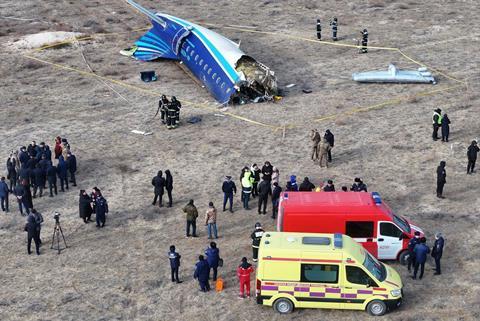
For example, in the case of last December’s E190 alleged shoot-down, the question arises as to why Azerbaijan Airlines’ operations department in Baku let the flight to Grozny go ahead despite knowing that the destination was in an active conflict zone associated with the war between Russia and Ukraine.
Equally, why did the crew decide to proceed even after Russian area control warned them that hostile Ukrainian drones were present and that the Russian military was engaged in shooting them down? To add to that, the weather at Grozny also was distinctly marginal.
There have been plenty of recent examples indicating why such risks should be avoided. In 2014, a Malaysia Airlines 777 operating flight MH17 from Amsterdam to Kuala Lumpur was shot down over eastern Ukraine by a Russian surface-to-air missile, killing all on board. Many airlines had already stopped using that part of Ukrainian airspace because Russian-backed Ukrainian separatists were fighting there, but some took the risk of continuing to use it.
In October 2001, a Siberian Airlines Tupolev Tu-154 flight from Tel Aviv to Novosibirsk was accidentally shot down near Crimea by a Ukrainian missile that had been fired at a target drone during a military exercise, but instead homed in on the airliner. All 12 crew and 66 passengers died.
Then, in January 2020, a Ukraine International Airlines 737-800 was shot down by Iranian forces after taking off from Tehran airport bound for Kyiv. This is believed to have been the result of a misidentification by Iranian forces of the aircraft as a hostile movement. All nine crew and 167 passengers were killed.
With the high number of conflict areas or disputed territories around the world at present, perhaps airline operations departments should take the risks involved in flying through – or even close to – such zones more seriously?
Following the Azerbaijan Airlines event, the European Union Aviation Safety Agency (EASA) issued an advisory suggesting that all aircraft avoid entering five of the Russian Federation flight information regions: Ekaterinburg, Moscow, Rostov-on-Don, Samara, and St Petersburg. EU-registered aircraft already refrain from using Russian Federation airspace, so this advisory is aimed at foreign operators who have third-country EASA authorisation.
This year’s report, meanwhile, also details several accidents that are puzzling because their flight profile before crashing is difficult to understand, given the dearth of information at this stage.
One example is the Saurya Airlines Bombardier CRJ200 which crashed just after take-off from Kathmandu, Nepal on 24 July. The regional jet had taken off to carry out a ferry flight to Pokhara for maintenance after a period of grounding, and those on board were airline staff. The weather was good and the aircraft lightly laden, but just after a rapid rotation into a steep climb the right wing dropped dramatically and the crew failed to recover control before impact with the ground, with 18 killed.
Another puzzle is the 25 November crash of a European Air Transport 737-400 freighter, operating for DHL, which had intercepted the instrument landing system for a night approach to runway 19 at Vilnius, Lithuania. The approach appeared to be going well until, passing 400ft, the crew were told to call the tower frequency. They never did, and video shows that a wing dipped and contacted the ground a little less than 1nm (1.8km) from the runway end, causing the aircraft to break up, killing one person.
Separately, Boeing continues steadily on its journey to build a robust, custom-made safety management system (SMS). The previous lack of such a mechanism has become accepted at the US Federal Aviation Administration (FAA) and within the company itself as the reason why accidents like the two 737 Max crashes late last decade were able to happen.
The FAA has been almost as heavily criticised as Boeing over the sloppy corporate safety culture and poor engineering quality control that had been allowed to develop unchallenged over the years since the company’s merger with McDonnell Douglas in 1997.
Now the agency meets regularly with Boeing at the highest level, and in early December 2024 FAA administrator Michael Whitaker – having spent time walking the floors at Boeing’s Renton and Everett plants – met the airframer’s relatively new chief executive Kelly Ortberg (who had been appointed in August 2024), to review progress with the SMS.

“As expected, Boeing has made progress executing its comprehensive plan in these areas, and we will continue to closely monitor the results as they begin to ramp up production following the strike,” he said. He was referring to the International Association of Machinists and Aerospace Workers’ strike that began in September and lasted nearly two months, stopping production at Renton and Everett.
EDUCATION PROGRAMME
When Boeing eventually reached agreement with its workers, it decided that the plants should remain stood down while it carried out a safety education programme with the workforce, as an essential part of building its new SMS. Whitaker later remarked in public that Ortberg’s decision to delay resumption of production to allow this to happen was a good sign.
What happens at Boeing matters because it has always been an industry icon, and if things are not right with Boeing, then the rest of the aerospace world should look nervously at its standards too.
Our annual accident listing uses data from Flight International’s research, in association with Ascend by Cirium.
Supporting documents
Click link to download and view these filesFlight International full-year accident listings 2024
PDF, Size 11.5 mb

